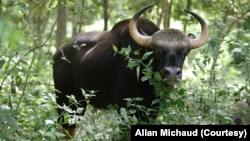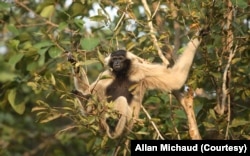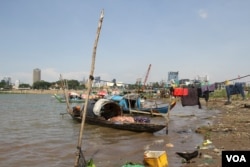A mining company's search for gold is creating "extraordinary" threats to Cambodia's Prey Lang Wildlife Sanctuary, according to a new report by the Swiss international organization Bruno Manser Fonds, which focuses on human rights and the environment.
Late Cheng Mining Development Company is developing two large-scale gold mines in Kampong Thom province, around 200 kilometers from Phnom Penh, Cambodia's capital, according to the report.
The $13 million, 15,000-hectare project is expected to last 15 years and generate 300 jobs, according to the Council for Development of Cambodia.
Ung Dipola, director general, general department of mineral resource in the Ministery of Mines and Energy, said the company has a production capacity of 180 kilos of gold per year and had planned a trial operation for this past August, according to news site Cambodianess.
The report says satellite images show that Late Cheng began commercial production of gold at its main mine complex in 2020, just a few months after obtaining permission to explore for gold and almost 18 months before receiving permission to begin commercial production.
According to the BMF report, "these developments pose a direct threat to the environment in the biologically most important evergreen lowland forest of Southeast Asia." Using satellite and drone imagery, BMF found damage caused by mining operations including "the use of cyanide, which is apparently [being] used for gold extraction."
Images show the potentially deadly chemical spreading through the area as it runs into rivers and streams, creating hazards for humans and the environment.
According to the report, the environmental impact assessment (EIA) for the Late Cheng mines is not publicly available. "The public has no understanding of how impacts were assessed, what biodiversity was assessed, what contingency plans for a spill or other contamination are in place, or what clean-up and restoration work will be required after the mines close."
"This EIA, if one was produced at all, is clearly inadequate given the environmentally harmful activities that have taken place within the concession area," the report said
Among the endangered species threatened by the mining activity are gaur — also known as Indian bison — which are susceptible to domestic cattle diseases, and pileated gibbons, which prefer old-growth forests with dense evergreen cover, according to the Animal Diversity Web at the University of Michigan's Museum of Zoology.
BMF called on the Cambodian government to revoke the mining licenses in the Prey Lang Wildlife Sanctuary and ban large-scale mining projects there in the future.
The 400,000-hectare wildlife sanctuary was established in 2016 to protect the forest, according to the report, which says the mines "are obviously not in line with the protection of the area."
Even without gold mining, the sanctuary's forests face longtime threats including illegal deforestation, power-line development and poaching, according to the report. It added that thousands of forested hectares and much biodiversity are already lost.
According to the Council for the Development of Cambodia, Cambodia's highest decision-making level of government for private and public sector investment, the mining company was licensed to mine gold in Kampong Thom Province in 2022.
One of the company's owners is Cambodian. The other four are Chinese nationals who have obtained Cambodian citizenship, which puts them on par with Cambodian natives for owning and operating a business.
Nguon Rattanak, governor of Kampong Thom Province, told VOA Khmer that all foreign companies mining gold in his jurisdiction have obtained licenses to operate. He said the companies report annually on their activities to the provincial governor.
VOA Khmer contacted Minister of Mines and Energy Keo Rattanak, and Ung Dipola, the ministry's director general, general department of mineral resource, but has yet to receive a response.
Last year, Ung Dipola confirmed to local media that the relevant authorities had fully assessed the environmental and social impacts before providing a license to Late Cheng Mining Development to extract gold.
VOA Khmer contacted Phay Bunchhoeun, spokesperson for the Ministry of Environment; Tob Kakada, director of the Kampong Thom Provincial Environment Department; and Late Cheng Mining Development by telephone for comment on the BMF report but received no response.
Hoeun Sopheap, a member of the Prey Lang Community Network in Kampong Thom Province, told VOA Khmer that he worries about cyanide and other chemicals he believes are used by the mining company flowing into local waterways, creating widespread environmental impacts. He added that the mining company failed to compensate people forced to leave the area.
The company appears to be out of compliance with laws governing the sanctuary and isn't transparent about its activities, he said.
''We are extremely concerned because they're taking raw materials that are Cambodian but only the mine owners, not Cambodians, are benefiting," he said. "We see that some activities are illegal, and some government officials are backing the company, but there is no consultation with the people."
Heng Kimhong, who heads the research and advocacy program of the Cambodian Youth Network Association, echoed concerns about the mines' use of chemicals, including some that are known to cause health problems in people exposed to them. The cyanide believed to be in use at the mines can cause heart, brain and nerve damage.
"I urge the government to consult with stakeholders, in particular independent experts and local groups of people who, prior to mining, license a company to explore or doing business," said Heng Kimhong.
The Late Cheng mine is in the immediate vicinity of the Porong River, which flows into the Stung Chinit River and on to the Tonle Sap River, which is a UNESCO Biosphere Reserve that supplies fish and other food to hundreds of thousands of people.
According to the report, "Dozens of kilometers of streams have already been directly impacted, but downstream impacts have not been assessed."









